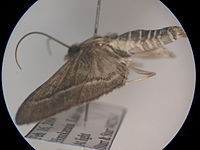- Omiodes continuatalis
-
Omiodes continuatalis 
Conservation status Scientific classification Kingdom: Animalia Phylum: Arthropoda Class: Insecta Order: Lepidoptera Family: Crambidae Genus: Omiodes Species: O. continuatalis Binomial name Omiodes continuatalis
(Wallengren, 1860)Synonyms - Salbia continuatalis Wallengren, 1860
- Botys continuatalis
- Loxocreon continuatalis
- Nacoleia continentalis
- Phostria continuatalis
- Hedylepta continuatalis
Omiodes continuatalis is a species of moth in the Crambidae family. It is endemic to Kauai, Oahu, Molokai, Maui, Lanai and Hawaii. It was first cited as possibly extinct by Gagné & Howarth in 1982. It was listed as extinct by the Hawai‘i Biological Survey in 2002 and the IUCN in 2003, but was rediscovered later in 2003.
The larvae feed on various native and non-native grasses, including Heteropogon contortus and Paspalum conjugatum. The larvae hide among the mass of dead leaves at the base of the tufts of grass and feed on the lowermost accessible green leaves instead of feeding on upper leaves and hiding in a rolled up leaf, as several of the other species of Omiodes. Full-grown larvae are 28-30 mm long and testaceous-green, with a rosy tinge.
The pupa is formed in a slight cocoon in the same place that the caterpillar used as a retreat. It is 13-15 mm long and very dark brown. The pupal period lasts 12-15 days.
Source
- Haines, W.P. 2004. Omiodes continuatalis. 2006 IUCN Red List of Threatened Species. Downloaded on 31 July 2007.
- Insects of Hawaii. Volume 8, Pyraloidea
- Rediscovery of five species of Omiodes Guenée (Lepidoptera: Crambidae) on Hawai‘i Island

This Spilomelinae-related article is a stub. You can help Wikipedia by expanding it.


